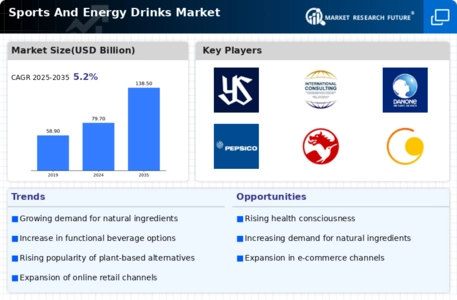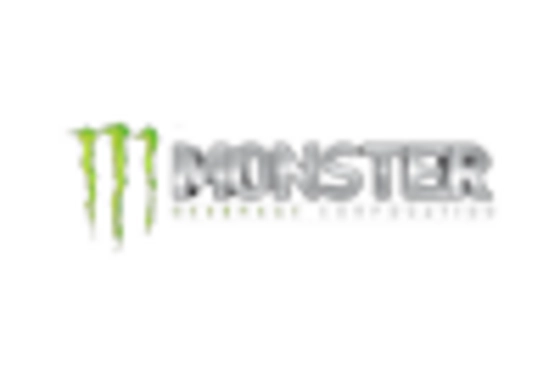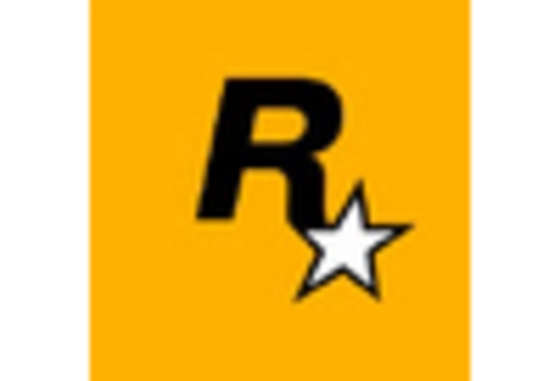Increased Fitness Awareness
The growing emphasis on fitness and wellness among consumers appears to be a primary driver of the Sports And Energy Drinks Market. As individuals increasingly prioritize health, the demand for beverages that enhance athletic performance and recovery has surged. Recent data indicates that the fitness industry has seen a substantial rise in participation rates, with millions engaging in various physical activities. This trend correlates with a heightened interest in energy drinks that promise to boost endurance and hydration. Consequently, brands are innovating to cater to this market segment, offering products that align with consumers' health goals. The Sports And Energy Drinks Market is thus likely to benefit from this shift towards a more active lifestyle, as consumers seek convenient solutions to support their fitness journeys.
Focus on Sustainable Practices
The growing consumer preference for sustainability is influencing the Sports And Energy Drinks Market. As environmental concerns become more prominent, brands are increasingly adopting sustainable practices in their production and packaging processes. This includes using recyclable materials, reducing carbon footprints, and sourcing ingredients responsibly. Research indicates that consumers are willing to pay a premium for products that align with their values, particularly among younger generations. Consequently, companies that prioritize sustainability are likely to gain a competitive edge in the market. This trend not only addresses consumer demand but also positions brands as responsible corporate citizens. As sustainability becomes a key differentiator, the Sports And Energy Drinks Market may witness a shift towards more eco-friendly offerings, reflecting broader societal changes.
Expansion of Distribution Channels
The expansion of distribution channels is playing a crucial role in the growth of the Sports And Energy Drinks Market. Retailers are increasingly recognizing the demand for these beverages, leading to their availability in a variety of outlets, including convenience stores, gyms, and online platforms. This diversification allows consumers to access products more easily, thereby increasing overall sales. Recent statistics suggest that online sales of energy drinks have surged, reflecting a shift in consumer purchasing behavior. Additionally, partnerships with fitness centers and sporting events have further enhanced visibility and accessibility. As distribution networks continue to broaden, the Sports And Energy Drinks Market is poised for further expansion, catering to a wider audience and meeting the evolving preferences of consumers.
Youth Engagement and Marketing Strategies
The engagement of younger demographics through targeted marketing strategies is a significant driver for the Sports And Energy Drinks Market. Brands are increasingly focusing on appealing to millennials and Generation Z, who are known for their active lifestyles and social media presence. Marketing campaigns that leverage influencers and digital platforms have proven effective in reaching these audiences, resulting in increased brand loyalty and product consumption. Data shows that a substantial portion of energy drink consumers falls within the 18 to 34 age range, indicating a strong market potential. This demographic's preference for bold flavors and unique branding further fuels competition among companies. As brands adapt their strategies to resonate with younger consumers, the Sports And Energy Drinks Market is likely to experience sustained growth.
Technological Advancements in Product Development
Technological innovations in the formulation and production of sports and energy drinks are reshaping the Sports And Energy Drinks Market. Advances in food science have enabled manufacturers to create beverages that not only provide energy but also incorporate functional ingredients such as electrolytes, vitamins, and adaptogens. These enhancements cater to a more discerning consumer base that seeks products with added health benefits. Furthermore, the rise of e-commerce platforms has facilitated the distribution of these innovative products, allowing brands to reach a wider audience. As a result, the market is witnessing an influx of new entrants, each vying to capture consumer attention with unique offerings. This dynamic environment suggests that the Sports And Energy Drinks Market will continue to evolve, driven by ongoing research and development efforts.


















Leave a Comment